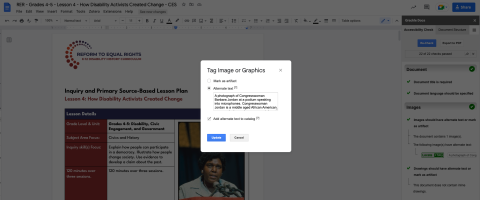Ensure that your digital education projects are fully accessible.
By Rich Cairn
When the Library of Congress launched the national “library service for blind patrons” (NLS) in 1931, it marked a key point in the history of intellectual, professional, and civic life for disabled Americans. The U.S. Government would henceforth take the leading role in ensuring that news, research, literature, and ideas are available nationwide for blind and visually impaired Americans. (See an excellent history of the NLS.) My own family proudly recognizes my mother-in-law’s thirty years as a braille translator for the national system through the Milwaukee Public Library.
Today students and teachers increasingly rely on digital resources in and out of the classroom, a trend supercharged by the Covid-19 Pandemic. Access is a right for all. And everyone benefits when educators learn and use the ever-growing tools for digital access.
Over the summer and fall of 2022, Alison Noyes from Emerging America aided KidCitizen’s Bert Snow as he developed Approaching Digital Accessibility, a primer and resource guide for educators. (Available in interactive online format as well as open Google doc and PDF download.)
The primer offers a brief history and overview of accepted accessibility guidelines through a summary of technologies, “How to get started,” and ample links for further help. It’s certainly the place to begin. Depending on the scale and type of your digital education project, your school or organization may need–and may already have–additional professional consultation.
I note as example that as lead writer and editor of the new Reform to Equal Rights: K-12 Disability History Curriculum (coming in February 2023), I have been using Grackle, a handy tool to identify and fix points of access in Google docs. That accessibility is one significant reason that we will publish Reform to Equal Rights lesson plans in an open Google doc format. The screen cap below demonstrates me entering alt text for a featured photo in a grade 4-5 lesson. With 200+ primary sources in 23 lessons, this tool has been invaluable to methodically strengthen and manage accessibility. The Collaborative for Educational Services pays a modest subscription fee for Grackle.





